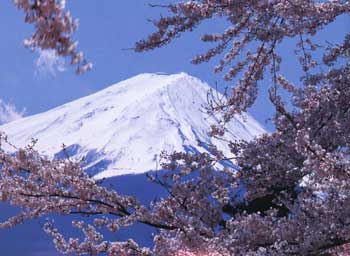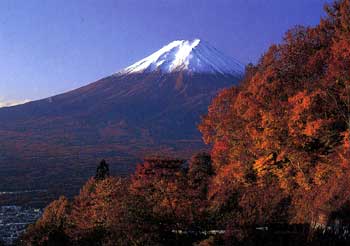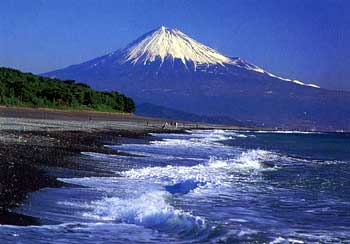

|

 |
Mt. Fuji |
 |

Mt. Fuji ( Spring )
Cherry blossoms, colza blossoms, and other flowers bloom in all
their glory to proclaim the advent of spring. The lovely flowers
from a beautiful contrast to Mt. Fuji whose summit is still fully
covered with the remaining snow. There are numerous scenic resorts
where visitors can enjoy a view of Mt. Fuji and the cherry blossoms
together. |

Mt. Fuji ( Summer )
Summer is
the most pleasant season for climbing Mt. Fuji. Climbers and hikers
can enjoy
the picturesque view of the contrast between the green forests on
the slopes of
Mt. Fuji and theblue sky and white clouds above. |

Mt. Fuji ( Autumn )
Trees on the slopes of Mt. Fuji and its surrounding mountains are
ablaze with autumnal tints of yellow, scarlet, and gold. Brightly
colored leaves make a fine contrast with Mt. Fuji. |

Mt. Fuji ( Winter )
In winter, Mt. Fuji is clothed in its garbs of snow and shines brilliantly
in the clear blue sky. The mountain is especially beautiful when
it is tinted with crimson in the morning glow and tinged with a
rosy flush at sunset. |
| Various Aspects of Mt. Fuji |
 The
formation of Mt. Fuji dates from tens of millions of
years ago when a submarine volcano erupted. The present
conical from of the mountain is believed to have emerged
approximately 10,000 years ago. A volcano of the simple
cone type, Mt. Fuji is Japan's highest mountain, rising
3,776 m.(12,3888 ft.) above sea level.
The
formation of Mt. Fuji dates from tens of millions of
years ago when a submarine volcano erupted. The present
conical from of the mountain is believed to have emerged
approximately 10,000 years ago. A volcano of the simple
cone type, Mt. Fuji is Japan's highest mountain, rising
3,776 m.(12,3888 ft.) above sea level. |
 The
elegant, majestic Mt. Fuji has long occupied an extraordinary
place in the mind of the Japanese. The existence of
more than three hundred "Mt. Fuji of one's home
province" (mountains whose name is called by adding
the suffix "Fuji") throughout Japan testifies
to how much the Japanese love and respect the mountain.
Ezo Fuji (Mt. Yotei, Hokkaido) and Satsuma Fuji (Mt.
Kaimon, Kagoshima) are examples of "Mt. Fuji of
one's home province" because they are similar to
Mt. Fuji in shape. In addition, there are a number of
mountains throughout Japan that are called likewise.
Some of them are famous mountains that represent the
province in which they are located and others are places
of mountain worship.
The
elegant, majestic Mt. Fuji has long occupied an extraordinary
place in the mind of the Japanese. The existence of
more than three hundred "Mt. Fuji of one's home
province" (mountains whose name is called by adding
the suffix "Fuji") throughout Japan testifies
to how much the Japanese love and respect the mountain.
Ezo Fuji (Mt. Yotei, Hokkaido) and Satsuma Fuji (Mt.
Kaimon, Kagoshima) are examples of "Mt. Fuji of
one's home province" because they are similar to
Mt. Fuji in shape. In addition, there are a number of
mountains throughout Japan that are called likewise.
Some of them are famous mountains that represent the
province in which they are located and others are places
of mountain worship. |
 Mt.
Fuji is called "Aka(red)Fuji" when it is tinged
with red at sunset. Lake Shoji is famed for offering
the most beautiful view of Aka Fuji. It is called "Kurenai(crimson)Fuji"
when it is tinted in deep red in the morning glow. Lake
Motosu is the most famous place for viewing Kurenai
Fuji. Around the spring and autumnal equinoctial weeks,
it is called "Diamond Fuji" because it shines
like a diamond when the sun rises from behind its summit.
Mt.
Fuji is called "Aka(red)Fuji" when it is tinged
with red at sunset. Lake Shoji is famed for offering
the most beautiful view of Aka Fuji. It is called "Kurenai(crimson)Fuji"
when it is tinted in deep red in the morning glow. Lake
Motosu is the most famous place for viewing Kurenai
Fuji. Around the spring and autumnal equinoctial weeks,
it is called "Diamond Fuji" because it shines
like a diamond when the sun rises from behind its summit. |
|
|
| |
|

|

